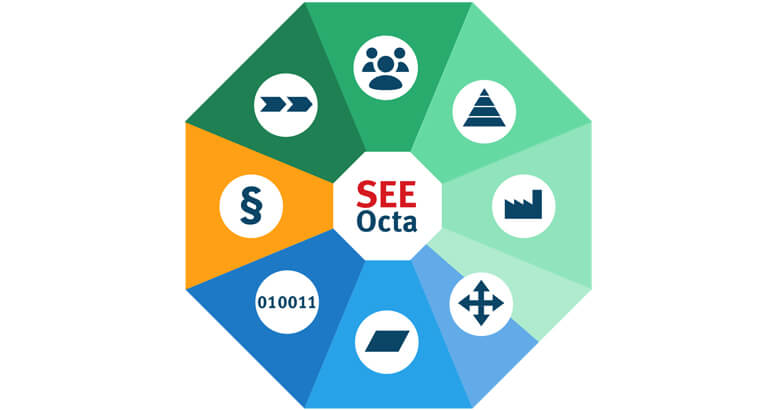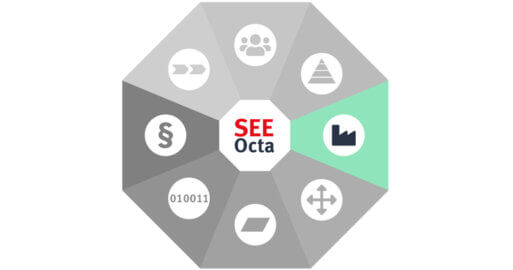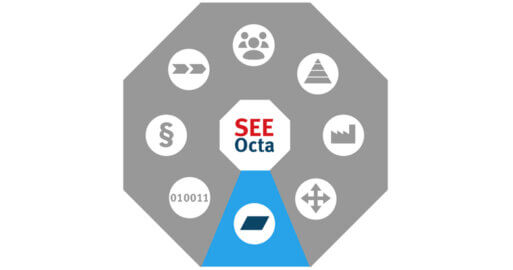SEEOcta in Use, pt. 1: An Example Project for Automating The Purchase-to-Pay Process

Automating a whole purchase to pay process in a company is pretty complex. On the one hand, you need an overview of a company’s processes so that you know what is involved. On the other hand, you need to scrutinise each process individually to identify its specific requirements and dependencies. These steps have been covered in various posts in the SEEOcta series. Discover here how you could use the SEEOcta approach to assess the current situation in your company and why it’s beneficial to take a cross-departmental, holistic view.
The SEEOcta blog series looks at all the areas you need to consider in your digitalisation and integration plans. These pointers are suitable as both a foundation and guide to planning your project and helps you ensure that you’ve considered every aspect to your IT project.
What is a purchase to pay process?
A purchase to pay process begins with a need and comprises several operative steps including the purchase request, delivery, billing and payment. Within these steps are also verification and approval processes, financial reporting, supplier master data management, performance monitoring and archiving.
Monitoring and reporting tools throughout this automated, digital process deliver clear, transparent data, which is also useful for applications such as cash flow planning. Furthermore, the tools ensure that all processes comply with current, relevant legislation. These inbuilt automated compliance checks are extremely helpful as, the SEEOcta article on laws and regulations , shows how legislation and security requirements are liable to quick yet comprehensive change.
How can the SEEOcta approach help evaluate a purchase to pay process?
The following matrix can help you gauge the quality of a purchase-to-pay process.
| SEEOcta perspective | Elementary | Advanced | The Goal |
| Processes |
Fragmented, functionally-oriented processes that are not harmonized between purchasing and accounting; inadequate process documentation, lack of integrated supplier connectivity. | Some end-to-end process design, but issues in the procurement process also cause problems in accounts payable. Suppliers are insufficiently integrated. | An end-to-end process with a defined owner. Up-to-date process documentation and work instructions. Suppliers are highly integrated. |
| Locations / strategy | Purchase-to-pay activities are operated locally in individual companies or even at division level. Processes are adapted to local and functional needs and circumstances. | Occasional outsourcing of individual steps to a shared service centre or external service providers. | The organisation is aligned to the purchase-to-pay process, rather than the other way around. Shared services and outsourcing is strongly used when appropriate. |
| Applications
|
Patchwork ERP system landscape with limited global reporting on expenses, payments, etc. Hardly any digitalisation or interconnectedness through technologies such as EDI. | One ERP system, however with exceptions, workarounds and interfaces. When it comes to reports, Excel spreadsheets are still the only way to get an overview of expenses, etc. | A single end-to-end ERP system is deployed across the entire organisation, enabling transparency and global purchase-to-pay reporting. EDI and other paperless technologies are heavily used. |
| Data | Master data records exist in multiple copies, managed decentrally by individual departments/company divisions. No corporate-wide policies to ensure data quality. | Shared maintenance of master data, but with many local variations and no policies from the top for how to maintain these records. | Shared master data maintenance with standardised relationships between global suppliers yet allowances for local specifications (e.g. account details). Central master data management is through a shared corporate portal. |
Figure 1: SEEBURGER Matrix for assessing your purchase-to-pay process.
A purchase-to-pay-process demands a cross-departmental approach
For a purchase-to-pay process to work well, those involved need to see the whole picture. There also needs to be someone taking responsibility through every step of the process. How crucial this is can be seen in the example of an invoice being processed. For this stage alone to work fast, error-free and at low cost, the following elements need to work frictionlessly with one another:
- Purchasing and accounts payable work closely together.
- The financial and ERP systems are connected and communicate with each other.
This is done through taking a cross-departmental, process-orienteered approach
- Purchasing and bookkeeping share a central archive and are connected to the same central ERP system.
- Invoices are digitally processed.
In turn, this all requires
- Automated checks between orders and deliveries and
- Automated entry into system and payment.
Excellent processes need to be properly supported by appropriate technology and data governance policies. However, neither excellent systems nor centralised, well-ordered data are enough to ensure clear, efficient processes. Both the purchasing process and bookkeeping need to be properly supported by simple, flexible workflows, centralised monitoring and further technical functions.
You need to consider all eight of the perspectives illustrated in SEEOcta to ensure that your new purchase-to-pay process is a success for it‘s the combination of factors such as strategy, applications, technology, processes and organisational structure which lets you see the process as a whole.
Automating and digitalising your purchase to pay process does not only eliminate the time lost at the classic handover points it also makes the process more transparent and improves overall administration quality.
Modern purchase-to-pay solutions support the whole purchasing process, from approving purchases and purchase orders to a full electronic exchange of data from documents such as the purchase order, order confirmation, a delivery slip and, of course, the invoice. Read part two of this post to discover more about actually implementing a new purchase-to-pay solution.
Thank you for your message
We appreciate your interest in SEEBURGER
Get in contact with us:
Please enter details about your project in the message section so we can direct your inquiry to the right consultant.
Written by: Andres Mathot
Andres Mathot has been working for SEEBURGER as an e-invoicing expert since 2015. As a customer contact for SEEBURGER e-invoicing solutions, he is responsible for consulting, planning, implementing, monitoring, testing and signing off implementation projects. Working together with our customers, he defines a customer‘s e-invoicing needs and how to best implement them, whether cloud-based or on-premises, for both incoming and outgoing invoices.




